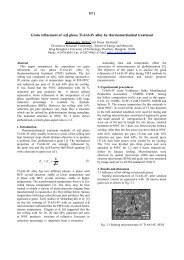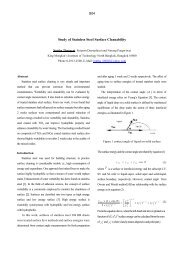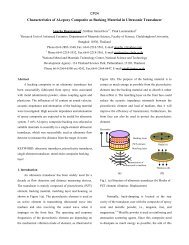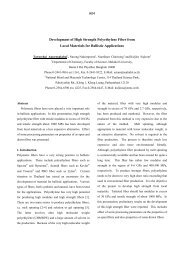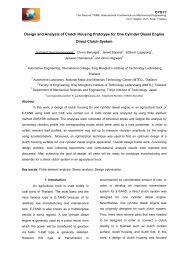EUROPEAN WHITE BOOK
EUROPEAN WHITE BOOK
EUROPEAN WHITE BOOK
Create successful ePaper yourself
Turn your PDF publications into a flip-book with our unique Google optimized e-Paper software.
MAX-PLANCK-INSTITUT FÜR METALLFORSCHUNG STUTTGART52percent (50 million tons) equivalent to a production valueof ca. 100 billion €.Processing of plastics as distinguished from the productionis an industry of own character and constituency.While the production of polymers is dominated worldwideand even more so in Europe by very few big players – thechemical industry – , the processing industry is characterizedby thousands of small and middle sized industries (e.g.in Germany one finds ca. 2.500 enterprises with a total ofca. 220.000 employees). About 60 percent of the productionof polymer materials is used to supply structural materialsto the market. 40 percent are produced to serve asfunctional materials.(a) Structural polymersMost of the polymers produced as structural materials(“standard plastics”) are based on polyolefines (polyethylene,polypropylene, and similar hydrocarbon polymers andcopolymers). The final application is found in the areas ofpackaging (41 %), construction of buildings (20 %), electricinsulations (9 %), automobile parts (7 %), agriculture (2 %)and miscellaneous (21 %). The application of plastics tosubstitute more conventional materials (e.g. metals, glass,ceramics in the packaging industries) or to develop newtechnologies (e.g. audio/video discs) is innovative and aconstant source of industrial evolution. We also find substitutionof more expensive “specialty” polymers by newgenerations of “commodity” polymers. This relates to theconstant improvement of the processing properties andphysical characteristics of polyolefines by the inventionand adaption of novel catalysts in the polymerization processes.The new structural variations at the level of themolecular architecture lead to a constant evolution of theproperties in application.Innovation in, e.g., the food packaging industries by availabilityof new or improved polymer based materials is essentialto the development of the distribution and storagesystems in Europe and assists in the restructuring anddevelopment of the agricultural regions. The large-scale replacementof glass by polyester-based materials (“PET”) forfluid containers in the soft-drink industry is another example.The initial problem of plastics waste disposal has beensolved in recent years by a combination of legal actions andeconomically viable collection and redistribution systems.It is necessary to mention that speciality polymers have afirm place in modern industry and have frequently thecharacter of an enabling technology. An example is the production,application, and constant evolution towards improvedperformance of epoxyresins, a class of polymerswhich serves as insulation and packaging material in theelectric/electronic industries. It is basic to modern electronicindustries.(b) Functional polymersPolymers produced as functional materials serve in a multitudeof applications as additives, processing aids, adhesives,coatings, viscosity regulators, lubricants, and manymore. They are found in cosmetics and pharmaceutics, inall kinds of semi-prepared foods, in printing inks and paints,as superabsorbers in hygienic products and in the processingof ceramics (“binders”) and concrete, as flocculants inwaste-water treatment and as adhesive in the hardware productionof electronic equipment, just to mention a few.New developments of functional polymers have had revolutionaryeffects on the industries in which they found applicationin that they provided the enabling technologicalbase to novel or improved production systems. Moreoverin many cases totally new applications became available.An example is the now widespread use of superabsorbersin personal care products, which in itself created a totallynew industry with novel product lines. The biomedical applicationof polymers needs also to be mentioned here.Polymers play an increasing role as implants, in dentistry, inthe surgery of connective tissue and arteries as well as ingeneral medical technology. It constitutes a large marketof its own right and of interdisciplinary research activities.One also needs to mention that the provision of novel functionalmaterials has also large repercussions on the machineand production line industries. A good example isthe printing machine industry. Progress in this industrydepends largely on the provision of new printing inks optimizedfor high speed printing processes – largely a “polymerproblem”. The same is true for “laser-printing technics”,the speed of which depends largely on the polymerbased printout process.1.6.3. Research TopicsA survey among the European Industries leading in polymerproduction in the years 1998/99 gave the followinghigh-priority targets for research devoted to polymers:• Emulsion polymerization: find ways to go from batch typereaction to continuos reaction; this would need the developmentof new, most probably polymeric surfactants;the stability of emulsions and dispersions needs to beimproved, the aging and film formation need to be bettercontrolled; this would have enormous impacts on thecoatings and adhesives industries:







